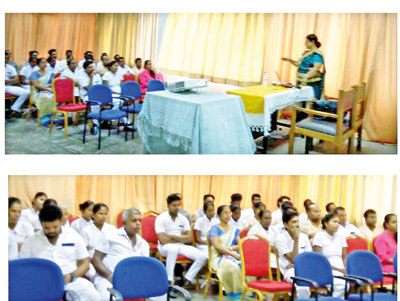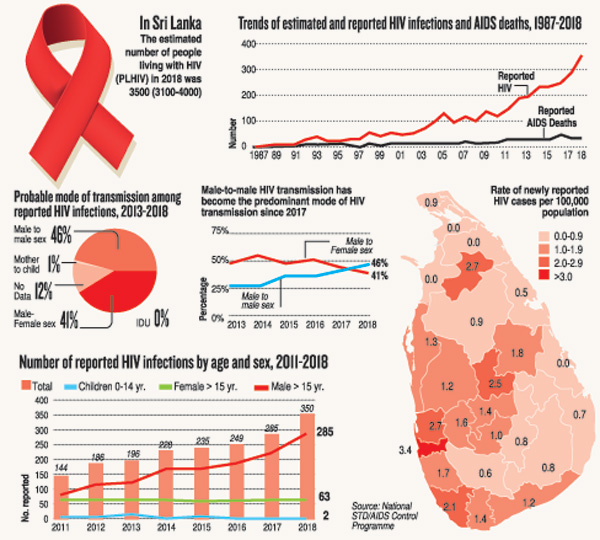News
Much positive action in curbing HIV
Sri Lanka has come a long way in preventing and controlling HIV but there are a few more miles to go. A major success story is curbing mother-to-child transmission, with the country seeking certification from the World Health Organisation (WHO) to declare elimination status.

An awareness programme on HIV/AIDS being conducted by the AIDS Foundation } Lanka for the junior staff of the Sri Jayewardenepura Hospital in June this year.
“Not having a single case of mother-to-child transmission of HIV is a major achievement for Sri Lanka,” said the Vice-Chairperson of the AIDS Foundation Lanka, Dr. Pramilla Senanayake, as the world commemorates World AIDS Day today (December 1).
There are around 250 children affected or afflicted by HIV, having contracted the illness through mother-to-child transmission earlier, the Sunday Times learns.
Focusing first on the world and then on Sri Lanka, Dr. Senanayake says that 39 million people are living with HIV across the globe. In Sri Lanka, there have been 200 deaths (a cumulative number) so far due to HIV/AIDS (Human Immunodeficiency Virus/Acquired Immunodeficiency Syndrome), while there are about 200 new infections among adults per year and about 3,500 people living with the disease.
There is now an ambitious, but achievable, goal set by UNAIDS, she points out, detailing it as 90-90-90 by 2030. “The target is for 90% of the infected people to know their status, with 90% of that group receiving treatment and 90% of the latter having viral suppression.”
People living with HIV must be armed with the knowledge that HIV is not curable but controllable and that they need to be on anti-retroviral (ARV) medication throughout their lives, if the doctors have prescribed the ARVs to them. It is vital not to start and stop, as the treatment cannot kill the virus, only suppress it effectively, says Dr. Senanayake.
“The government has a robust programme rooted in 31 clinics dealing with sexually transmitted diseases (STDs) across the country following the ‘Treat All’ Policy of the World Health Organisation (WHO), where the disease is diagnosed and managed and if there is a need patients are dispensed ARV medication, while also dealing with opportunistic infections. The authorities work in coordination with non-governmental organisations (NGOs) and the community,” she says.

Dr. Pramilla Senanayake
Looking closely at Sri Lanka which is a low-prevalence country for HIV, she says that though among the general population it is 0.1%, there are ‘Most At Risk People’ (MARP) who need to be empowered and supported to keep the illness at bay or under control. They are female sex workers; men who have sex with men including transgender people; and injecting drug users. “With the country having around 40,000 female sex workers and about 35,000 men who have sex with men, efforts have to be made to get into their groups and use a window of opportunity to forestall the infection from spreading. Injecting drug users are not a major worry as they are less than 0.1% in our population.”
Dr. Senanayake says that the Family Planning Association is doing a lot of work in these arenas, using peer educators while the AIDS Foundation Lanka is striving to better the lot of the men, women and children living with HIV and also holding numerous training programmes to educate healthcare workers such as nurses and others including Scouts, three-wheel drivers, Free Trade Zone workers and the fishing community.
She elaborates on the challenges with regard to MARP as under-reporting of HIV infections due to poor knowledge, high-risk sexual behaviour with low condom use, high mobility (either from village to town or to a foreign country), barriers in seeking services and stigma and discrimination. “Even though there has been a slight improvement in dispelling stigma and discrimination, it is not enough. Parents living with HIV find it difficult to get their children into schools and people living with HIV cannot easily find houses to rent or employment.”
Recently, she had found a few people living with HIV a house to rent in a suburb of Colombo, after explaining the situation to the landlord. “The landlord was fine, but the moment the neighbours heard about the illness, they made such a fuss that the landlord was forced to tell his tenants to leave,” she says.
Looking at Sexually Transmitted Infections (STIs) as a whole, with Sri Lanka having between 60,000 to 200,000 cases, Dr. Senanayake says that only about 10-15% seek treatment at government clinics.

| AIDS Foundation Lanka always by their side | |
| Both Kamala* and her husband are living with HIV. Her husband is ill and unable to work and it is Kamala who has become the breadwinner, with support from the AIDS Foundation Lanka. The Foundation conducts awareness programmes across the country on HIV/AIDS, while linking those living with HIV to health and social services. Kamala, who is a peanut seller, the Foundation has empowered with a monthly allowance to keep the home fires burning for her family which also includes three children and an ailing mother. It has also extended a helping hand to Mala* and her son, both living with HIV in another part of the country. A street vendor, selling packets of lunch, to keep starvation away from their door and also educate her son, Mala had found that she was HIV Positive during medical tests when she wanted to go abroad for work. The father of her boy had abandoned her when she was pregnant and she had sought employment abroad after her son was born, only to face a double blow – living with HIV and abandonment by her man. These are just two of the many people living with HIV that the Foundation is supporting and also providing a shoulder to unburden themselves of their cares and worries. Meanwhile, the Foundation members visit the National Institute of Infectious Diseases, Angoda, which has an HIV ward, bearing gifts such as fruit, milk, yoghurt, biscuits, tea bags, sugar, toothpaste, toothbrushes, adult pampers, eau de cologne, powder, condom catheters and files which can be used for bed-head tickets, bringing a smile to patients. A recent donation to the ward was a TV. Silent but continuous has been the service by the AIDS Foundation Lanka for more than a decade. (*Names have been changed to protect identities) |

